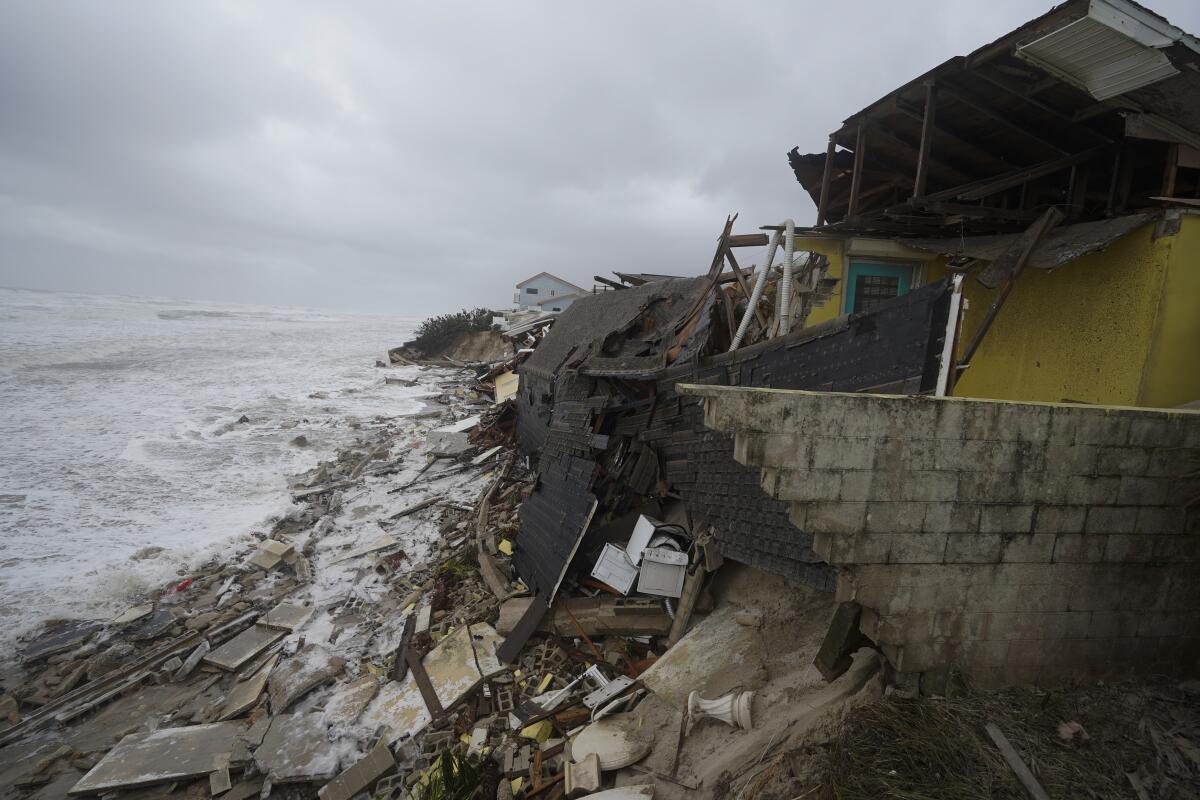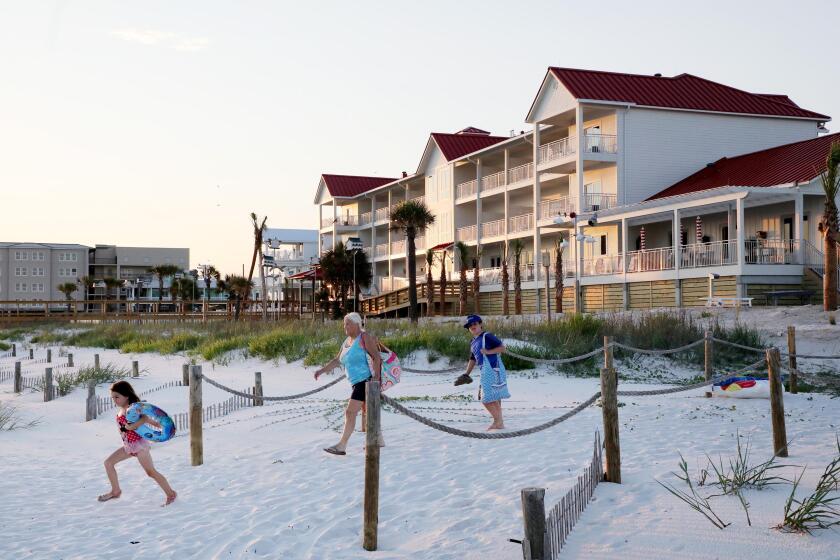Rains from Nicole douse eastern U.S. from Georgia to Canada

- Share via
WILBUR-BY-THE-SEA, Fla. — Heavy rain from the remnants of Hurricane Nicole covered the eastern United States from Georgia to the Canadian border Friday while hundreds of people on a hard-hit stretch of Florida’s coast wondered when, or if, they can ever return to their homes.
Parts of otherwise intact buildings hung over cliffs of sand created by pounding waves that covered the normally wide beach in Wilbur-by-the-Sea, near where Nicole made landfall. Dozens of hotel and condominium towers as tall as 22 stories were declared uninhabitable in Daytona Beach Shores and New Smyrna Beach after seawater undercut their foundations.
As waves washed over pieces of lumber and concrete blocks that once were part of homes at Wilbur-by-the-Sea, workers tried to stabilize remaining sections of land with rocks and dirt. It was too late for some, though: The front of one house lay on the sand, where it was sheared away from the rest of the structure.
Restoring Daytona Beach — famous for its drivable beach — and surrounding beaches will probably require a major, multimillion-dollar sand renourishment project and improved sea walls to protect property, said Stephen Leatherman, director of the Laboratory for Coastal Research at Florida International University.
Four years after a Category 5 hurricane hit Mexico Beach, the small Florida seaside town is building back. Is it becoming a preserve of the wealthy?
“It was known worldwide for driving on the beach,” said Leatherman, known as “Dr. Beach” for his annual ranking of U.S. beaches. “They don’t even have a beach to think about right now.”
As Nicole’s leftovers pushed northward, forecasters issued multiple tornado warnings in the Carolinas, although no touchdowns were reported immediately.
In south Georgia, Keith Post tried to clean up the damage at a coastal submarine museum that was submerged by floodwaters.
“At one point it was up to my knees,” said Post, whose St. Marys Submarine Museum sits on the river that forms the Georgia-Florida line at the Atlantic Coast. “From the front of the museum looking across to Florida, you did not see any green. It was all water.”
Downgraded to a depression, Nicole could dump 8 inches of rain over the Blue Ridge Mountains, forecasters said, and there was a chance of flooding as far north as New England.
Wrecks added to Atlanta’s notoriously bad traffic as rain fell across the metro area during rush hour, and a few school systems in mountainous north Georgia canceled classes.
The situation was a lot worse in eastern Florida. One roughly 15-mile-long area of the coast was severely eroded, with multiple seawalls destroyed. Much of the destruction was blamed on unrepaired damage from when Hurricane Ian crossed the state from west to east just six weeks earlier, killing more than 130 people and destroying thousands of homes.
Should Cape Coral and other low-lying cities in Florida rebuild in an era of more intense hurricanes, higher rainfall and rising seas?
Volusia County officials said it wasn’t clear when people might be able to sunbathe next to their cars and pickup trucks on the beaches again.
“Assessments have begun and will be ongoing as we have 47 miles of beach,” county spokesman David Hunt said.
The late-season hurricane hit the Bahamas first. For storm-weary Floridians, it was the first November hurricane to hit their shores since 1985 and only the third since record keeping began in 1853.
Even minimal hurricanes and storms have become more destructive because seas are rising as the planet’s ice melts because of climate change, increasing coastal flooding, said Princeton University climate scientist Michael Oppenheimer. “It’s going to happen all across the world,’’ he said.
The lifting of a curfew at 7 a.m. Friday and the reopening of bridges leading to the beachfront allowed evacuated residents to return to the area to take stock of their properties, if only from the outside. But safety officials warned people not to approach the wreckage, which could collapse at any time.
Survivors of Hurricane Ian face a long emotional road to recover from one of the most damaging storms to hit the U.S. mainland.
“If you go anywhere near the beach, you are putting your life in jeopardy. We are flying double red flags because there are massive amounts of debris in the water and on the beach, 5-to-8-foot breaking waves, and strong rip currents,” Tamara Malphurs, deputy chief of the Volusia County Beach Safety Ocean Rescue, told the Associated Press.
A man and a woman were killed by electrocution when they touched downed power lines in the Orlando area, the Orange County Sheriff’s Office said.
Another man died as waves battered his yacht against a dock in Cocoa, despite efforts to resuscitate him by paramedics who managed to get on board as the boat broke away from its moorings, Cocoa police said.
Nicole also caused flooding well inland, as parts of the St. Johns River were at or above flood stage. Some rivers in the Tampa Bay area neared flood levels, according to the National Weather Service. Emergency declarations were approved for all 67 Florida counties and the Seminole Tribe of Florida as the sprawling storm moved over the state.
Frisaro reported from Fort Lauderdale. AP writers Curt Anderson in St. Petersburg, Russ Bynum in Savannah, Ga., Jay Reeves in Birmingham, Ala., and Seth Borenstein in Sharm el-Sheikh, Egypt, contributed to this report.
More to Read
Sign up for Essential California
The most important California stories and recommendations in your inbox every morning.
You may occasionally receive promotional content from the Los Angeles Times.














